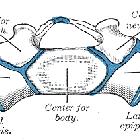Hiatus sacralis
The sacral hiatus corresponds to the posterior caudal opening at the end of the sacral canal, which usually occurs at the fifth sacral vertebra (S5), at the posterior surface of the sacrum.
Gross anatomy
Location
Commonly, the sacral hiatus corresponds to the non-formation of S5 spinous process . It can be palpable when following down the middle sacral crest through the natal cleft.
Boundaries
It is flanked bilaterally by the articular process called sacral cornua. Anteriorly there is the sacral canal, which, at this level, has no dural sac and contains only extradural fat, vertebral venous plexus, lower sacral nerve roots and the filum terminale. Posteriorly, covering the hiatus, is the sacrococcygeal ligament.
Contents
The fifth sacral nerve root exits via the sacral hiatus. The sacral hiatus is covered posteriorly by the sacrococcygeal ligament, subcutaneous fatty layer and the skin.
Related pathology
Caudal epidural injections used to treat sacral and lower lumbar nerve root impingement occur via the sacral hiatus.
Siehe auch:

 Assoziationen und Differentialdiagnosen zu Hiatus sacralis:
Assoziationen und Differentialdiagnosen zu Hiatus sacralis:
